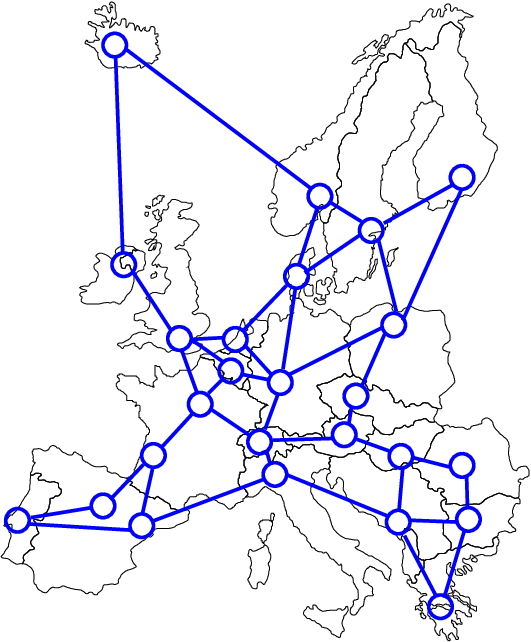Section: Application Domains
Network Design and Routing Problems
We are actively working on problems arising in network topology design, implementing a survivability condition of the form “at least two paths link each pair of terminals”. We have extended polyhedral approaches to problem variants with bounded length requirements and re-routing restrictions [47] . Associated to network design is the question of traffic routing in the network: one needs to check that the network capacity suffices to carry the demand for traffic. The assignment of traffic also implies the installation of specific hardware at transient or terminal nodes.
To accommodate the increase of traffic in telecommunication networks, today's optical networks use grooming and wavelength division multiplexing technologies. Packing multiple requests together in the same optical stream requires to convert the signal in the electrical domain at each aggregation of disaggregation of traffic at an origin, a destination or a bifurcation node. Traffic grooming and routing decisions along with wavelength assignments must be optimized to reduce opto-electronic system installation cost. We developed and compared several decomposition approaches [82] , [81] , [80] to deal with backbone optical network with relatively few nodes (around 20) but thousands of requests for which traditional multi-commodity network flow approaches are completely overwhelmed. We also studied the impact of imposing a restriction on the number of optical hops in any request route [79] . We also developed a branch-and-cut approach to a problem that consists in placing sensors on the links of a network for a minimum cost [53] , [54] .
We studied several time dependent formulations for the unit demand vehicle routing problem [40] , [39] . We gave new bounding flow inequalities for a single commodity flow formulation of the problem. We described their impact by projecting them on some other sets of variables, such as variables issued of the Picard and Queyranne formulation or the natural set of design variables. Some inequalities obtained by projection are facet defining for the polytope associated with the problem. We are now running more numerical experiments in order to validate in practice the efficiency of our theoretical results.
We also worked on the p-median problem, applying the matching theory to develop an efficient algorithm in Y-free graphs and to provide a simple polyhedral characterization of the problem and therefore a simple linear formulation [72] simplifying results from Baiou and Barahona.
We considered the multi-commodity transportation problem. Applications of this problem arise in, for example, rail freight service design, "less than truckload" trucking, where goods should be delivered between different locations in a transportation network using various kinds of vehicles of large capacity. A particularity here is that, to be profitable, transportation of goods should be consolidated. This means that goods are not delivered directly from the origin to the destination, but transferred from one vehicle to another in intermediate locations. We proposed an original Mixed Integer Programming formulation for this problem which is suitable for resolution by a Branch-and-Price algorithm and intelligent primal heuristics based on it.
For the problem of routing freight railcars, we proposed two algorithmes based on the column generation approach. These algorithmes have been testes on a set of real-life instances coming from a Russian freight real transportation company. Our algorithmes have been faster on these instances than the current solution approach being used by the company.


